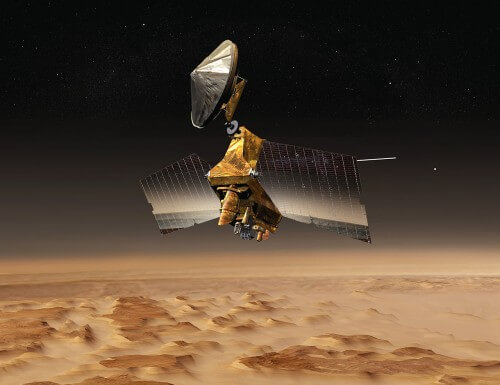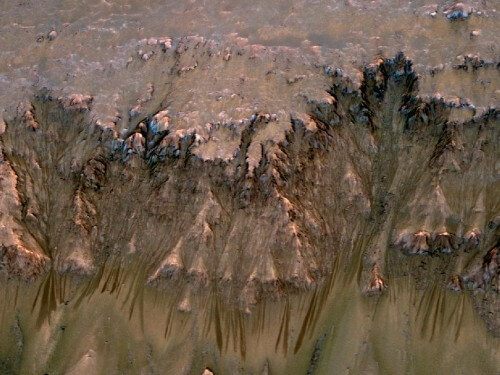The MRO spacecraft orbiting Mars since 2005 has taught us new things about the most studied planet in the solar system

Temperatures
Unlike the Earth, which has one peak temperature per day, which is at noon, Mars has two peak temperatures, one at noon and the other a little after midnight. The temperature fluctuations are 32 degrees. This phenomenon is global and throughout the year, and has a connection to the atmospheric tide (atmospheric tide - this phenomenon is a combination of fluctuations in wind, temperature and atmospheric pressure) known on Earth but not with such sharp fluctuations. The fluctuations on Earth are small and occur at the bottom of the atmosphere, although they have no contact with the ground. The waves of oscillations in the Martian atmosphere are of short duration throughout the entire atmosphere. Both on Earth and on Mars this phenomenon occurs every day due to fluctuations in winds, temperatures and atmospheric pressures. The tide on Earth is called diurnal and the cycle of the two oscillations on Mars is called semi diurnal. This unique phenomenon was noticed for the first time in 1970. It was estimated that they appear during seasonal dust storms associated with dust heated by sunlight in the atmosphere.
The explanation for the semi-dinural phenomenon is found in the clouds of water ice in the Martian atmosphere. These clouds exist most of the year in the equatorial region on their backs between 10 and 30 km above the ground. They absorb infrared radiation emitted from the ground during the day. As on Earth, these clouds are partly transparent. It was known that clouds of water ice create areas of cold temperatures, but the scope of their feedback on the temperature structure was not correctly estimated and that it would take years for the phenomenon to be fully understood (1).
Pockets of cold air were found in the atmosphere at an altitude of 60-90 km. In studies done in 1998, it became clear that these pockets are the result of atmospheric gravity waves. At these heights, the gravity waves are created when the wind rises above mountains and they can create temperature changes in the range of 12 degrees. The researchers hypothesized that this amount of cooling when it collides with a larger heat change in the mesosphere will shift the temperature to just under 80 degrees below zero which is the condensation point of 2CO (2). These cold air pockets were considered an addition to the mystery of the discovery of 2CO clouds.
Dust storms and upheavals
For the first time in years, NASA is monitoring a dust storm that caused atmospheric changes. The Viking spacecraft that landed on Mars in 1976 saw the first dust storm of this magnitude. Storms from recent years on a large scale were observed in 2001 and 2007. The dust storm observed in 2012 covered large areas in the same place where dust storms developed in the past that reached large scales, some of them regional in scope and some of them global in scope covering the entire surface of Mars. The dust storm in 2012 started in November at the beginning of spring in the southern hemisphere. On November 16 of this year, the MRO spacecraft noticed air warming 25 km above the dust storm. Since then the temperature in this area has increased by 25 degrees Celsius. It was clear that the origin of this warming is the dust storm that absorbs the sunlight at this altitude. High temperatures were also found in hot spots in high latitudes in the northern hemisphere near the pole caused by changes in the circulation of the atmosphere (3). On February 16, 2012, a dust devil was observed in Amazonis Planitia. The dust devil reached a height of 800 meters and a diameter of 30 meters. At that time, Mars was in its ephelion (4).
Snow of CO2

The observations showed that Mars has clouds of 2CO and they are large enough for CO2 to snow in the winter and accumulate on the ground. This snow is observed in the South Pole during the winter season. In the analysis of findings made in 2006 and 2007 in the southern hemisphere at the pole, a 2CO cloud with a diameter of 500 km above the pole itself and smaller clouds with a shorter life span were detected between latitudes 70 and 80 south. The CO2 ice particles are large enough to reach the ground throughout the lifetime of the clouds. The residual ice cap at the South Pole is the only place where it remains stable throughout the year (5). A comparative test between the poles showed that the CO2 snow particles in the Southern Hemisphere are somewhat smaller than those of the North Pole. The size of the particles in the northern hemisphere is between 8 and 22 microns and those in the southern hemisphere are between 4 and 13 microns in diameter. As Mars gets colder in both the northern and southern hemispheres, the clouds spread towards the equator. Once they reach half the distance they shrink and move back towards the poles. Like the snow on Earth, the 2CO snow also reflects sunlight. The way the light is reflected depends on various factors such as the size of the particles (6). CO2 freezes at 128 degrees below zero. At this temperature, small ice crystals form and accumulate in the form of clouds. They can be found north of 70 degrees north latitude in all layers of the atmosphere up to a distance of 40 km from the ground. The ice crystals formed at a distance of 20 km from the ground reach it as snow. For this to happen, the temperature changes must be the same throughout the atmosphere. In places higher than 20 km, the ice crystals come into contact with warmer air and undergo sublimation, in particular in the northern hemisphere in the space between 30 degrees West and 60 degrees East. In this region the 2CO ice caps reach especially the southern hemisphere. According to various calculations, they came to the conclusion that half of the seasonal ice reaches the ground as snow. From all the findings, the researchers came to the conclusion that snow storms can be predicted with a high level of reliability. The prediction range is similar to that of the Earth. At most 7 days ahead (7).
water
From a careful examination of the end of Valls Herbas - a channel that is 250 km long, the researchers came to the conclusion that two billion years ago a colossal amount of water was trapped in complicated systems of caves (8). Channels and chasms that underwent erosion created by massive floods between different basins are the evidence The strongest that in the past there was a large ocean on Mars. The obvious question is what is the source of the water. The accepted assessment is that the source is underground and hence the question arises as to how they reached the surface. The explanation given is that there are lakes at a depth of 5 km. The underground water slowly fills a basin until it reaches a height of several kilometers and then it spills out. In the same place where the water spills, there is rapid erosion and a channel is created that also undergoes erosion towards the basin they fill, they increase the erosion and the result is a large chasm. If this is indeed the process, the question arises, what caused the water to rise to the surface? It is possible that the reason for this is geothermal currents that pushed them upwards [author Haim Mazar's hypothesis(9)]. In some of the photographs you see the delta of a river that flowed towards a very large ocean that covered a third of the surface of Mars. The delta is in Dorsa Aeolis located on the boundary line between the area of the craters in the highlands of the Southern Hemisphere and the low plains of the Northern Hemisphere (10).
In the middle latitudes in the southern hemisphere there is a crater where gullies are well preserved and deposits of rock flows (debris). When sediments on a slope are saturated with water they become too heavy to stay in place and downward degradation results. Such a phenomenon is called a stream of rock fragments. In the course of such a flow, a mixture of stones, gravel, clays and water deteriorates down the slope. Similar formations on Earth are found in Svalbard, which is in Norway. It is estimated that this crater was formed 200,000 years ago (11).
linear gullies
Channels of this type are characterized by a constant width throughout their entire length and their banks protrude above the surface. Unlike water-carrying channels on Mars and on Earth, there are no rock fragments that have deteriorated downwards. The longest channels of this type on Mars were found in the Russell Crater. They are two kilometers long along the slope. They are found along the sand dunes inside the crater. The studies show that they were formed by 2CO ice blocks that slid down the length of the sand dunes. They form in early spring and move down on cushions of some of this ice that evaporates as the winter season ends and spring begins (12).
Note: atmospheric gravity waves
Sources
1. "Mars water ice clouds are key to odd thermal rhythm" 14.6.2013
http://www.marsdaily.com/reports/Mars_Water_Ice_Clouds_Are_Key_To_Odd_ Thermal_ Rhythm_999.html
2. "Martian Carbon Dioxide clouds tied to atmospheric gravity wave" 15.2.2012
http://www.marsdaily.com/reports/Martian_Carbon_Dioxide_Clouds_Tied_To_ Atmospheric_ Gravity _Wave_999.html
3. "NASA monitors massive dust storm o Mars" 26.11.2012
http://www.marsdaily.com/reports/NASA_Monitors_Massive_Dust_Storm_On_ Mars_999.html
4. "NASA Mars orbiter catches twister in action" 8.3.2012
http://www.marsdaily.com/reports/NASA_Mars_Orbiter_Catches_Twister_In_Action_999.html
5. "NASA observations point to dry ice snowfall on Mars" 12.9.2012
http://www.marsdaily.com/reports/NASA_Observations_Point_To_Dry_Ice_ Snowfall_ On_ Mars_999.html
6. "Researches calculate size of particles in Martian clouds of CO2 snow" 21.6.2012
http://www.marsdaily.com/reports/Researches_Calculate_Size_Of_Particles_In _Martian _Clouds _Of_ CO2_ Snow_999.html
7. "And now for the weather on Mars" 10.5.2013
http://www.marsdaily.com/reports/And_Now_For_The_Weather_On_Mars_999.html
8. "Ancient Mars may have captured enormous flood waters" 5.12.2012
http://www.marsdaily.com/reports/Ancient_Mars_May_Have_Captured_Enormous _Flood _Waters_999.html
9. Larry O'Hanlon - "Deep lakes and catastrophic floods on Mars" 9.5.2013
http:// newa-discovery.com/space/deep-lakes- of- ancient -mars-130509.htm
10. Wall Mike – "Ancient Mars may have flowed into huge ocean" 17.7.2013
http://www.space.com/21984-ancient-mars- may -have -river-delta.html
11. "Traces of recent water on Mars" 29.4.2014
http://www.marsdaily.com/reports/Traces_Of_Recent_Water_On_Mars_999.html
12. PIA17260: Linear gullies inside Russell crater, mars
http://photojournal.jpl.nasa.gov/PIA17260
